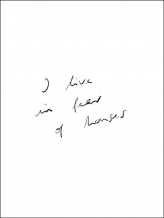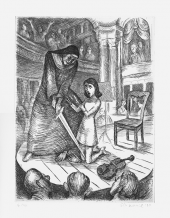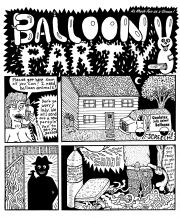| Revista Umělec 2006/2 >> A Better Life with Criticism | Lista de todas las ediciones | ||||||||||||
|
|||||||||||||
A Better Life with CriticismRevista Umělec 2006/201.02.2006 Simone Schardt | u-sobě | en cs |
|||||||||||||
|
Following up the tradition of thinking in decades that we find in the latest history of art, it seems that the decade 2000-2010 is a period of reflection and criticism of the conditions in which art is done: Meta-criticism is born. However, the question of conditions in the art world is just one target - another target is the increasing influence of criticism when it comes to the market value of art works. The strong ties between the TOP 50 Artists lists and art criticism today appears more questionable than ever before. Just as any other branch of culture production, art criticism had to act self-explanatory in terms of its tools. The demand for questions concerning the instruments of criticism, however, has reached the public ear. Two motifs have put criticism in a crisis: 1. The critic underlies the same socioeconomic dependencies as the artist, and, 2. Criticism concerns a product that is financed and sold in advance1. Not the art pieces are competing – a classic situation imparting the critic the function of a judge – instead the critical texts themselves are competing.
The principle of selection A year ago, an article published in this magazine asked the following question: Why do we read art magazines? Just by repeating the question you almost get the answer. The author’s aim was to define art magazines (resp. art literature) as the location of criticism.2 Not the kind of positivistic criticism that produces blueprints of life or whatever it is they produce while contradicting and abandoning the existing habits, but that kind of criticism that presently finds itself at risk of losing its identity as well as its personnel. Art criticism has fallen ill with the creeping disease of selection. Selection is the sharpest form criticism can take. The never-ending flow of art products pours into every existing corner of the art world. The critic doesn’t even have to leave their 15-inch desktop in order to find it. The art will come to them in the form of magazines, web sites, fliers, press releases and invites composed by eager interns. Face to face with these masses of information selection is work that clearly has to be done. But this is not enough. Criticism still needs to be performed – not as a affirmative description of an exhibition but offering more resistance and able to come up with a scathing criticism. Places of criticism Trying to help the happy Arty Jetset Family in terms of communication a private language has derived, created in long processes of differentiation and thoroughly distributed via the multiple veins of art media. There is a clear differentiation between daily press and art press whenever credibility becomes an issue. In general, the art media gets full credit for better quality. This is deceptive. With few exceptions, the art press is free of criticism - critics have become mere heralds of what’s news.3 Critical statements are rather found on the culture pages of daily papers. It seems that the daily press is able to accomplish lateral thinking outside of its own jargon thereby achieving the necessary critical distance, a skill, the authors of flashy art mags have lost the ability to perform. One of the reasons is the clear difference of economic dependence between the two professions. An editor of the culture section of a daily paper simply is an editor. An editor of a culture magazine is usually part of multiple art activities that obviously widen their influence in the art scene but seem to diminish their ability of being critical. A thorough reflection of these kind of art relations might sound helpful but will sustain nothing but wishful thinking. The subject of the critic Criticism describes the art of judgement. This is no call for the hard grip of art criticism performed in cultural salons of the 19th century - and even less so for the dichotomic-symbiotic and rather masculine phrased the art critic and his artist relation of modernism. This process will not be ended soon shown by the appearance of free critics in dissociation of the artist-bound critic. The free critic is the follow-up model of the free curator, taking its beginnings with Harald Szeemann and where the detachment of an institution as well as employer/employee relationship seemed rather logical. The purely fictional figure of a free art critic, on the other hand, appears to be a paradox, a last attempt of rebellion against modernism that is believed to have been overcome long ago. The appearance of a free art critic prepares the dissolution of the subject of the art critic itself, as from today the only art critics to be found in the scene will be critics-as-curators, critics-as-artists, artists-as-critics and other dualisms. This clearly has advantages and disadvantages. Of disadvantage obviously is the loss of absence of critical distance. A genuine advantage – referring especially to all artists-as-critics – is the detachment of academic formulas, rudiments of the salon culture. Representative texts can be found within the works of Robert Smithon4, or Michael Baldwin, Charles Harrison and Mel Ramsden demand for a discourse of second order5, promising an analysis of the return of criticism to art production. The futile call for authority Nevertheless, the strong call for a more coherent subject of the critic can’t be missed – thus, a constructed gap is creating all kinds of desire looking for a re-animated authority to fill the space. This authority should find its competence on expertise and specialized knowledge, which should be passed on by yet another institutionalized even higher authority. A hopeless attempt - as there is no academic qualification for how to become an art critic. By the way, this fate is shared with the profession of gallery owner. These professions still follow the unwritten and mythically embellished laws of calling. Another wish calls for a new and poetic language, a language of the heart. Would this language still comply with the requirements of a yet undesignated authority? Couldn’t it be that the desired instruments of language already exist but the courage for scathing criticism is missing? That the problem rather is not HOW to say something but WHAT to say? And couldn’t it be that it is the artists - who more or less maneuver in the eye of the hurricane - who are ready to find the courage to speak out? Simply because they have nothing to lose? Because they are standing at the end of the economic value-chain? Because they are the only ones anyway who are willing to read through a text of more than 4,000 characters? Today everyone else seems to miss out on social networking, lose their next business flight or miss a long looked-for working dinner. And, couldn’t it be that this available time quota mirrors the reciprocal means of power? The more time there is available the less its value in an economy of attention? What if criticism as a consequence of Frederic Jameson’s consternated loss of distance lost its power of the old salon days and, instead, became dependent on the culturebiz - even more, that criticism presents the weakest link in the culture chain? So what? A paradoxical situation: On one hand, there is a many-voiced moan for competent criticism, on the other hand, there is no one to fill the gap. Too engrained is the image of the critic as a server of truth, always fighting for the good. In these days nobody wants - and nobody can - take the position of an advocate beyond reproach. The old authority-aligned model has been redeemed by a multiplicity of voices. In order to ensure the survival of criticism these voices have to speak on-record and they must be heard. Otherwise we are at danger of even more boulevard exhibitions, which serve all tastes and don’t hold anything that is worth a critical mention. Criticism that merely uses a frictionless method of selection is superfluous anyway. 1) Philip Ursprung: "Niedergang der Kritik?" in Woz, Nr. 5, 2. Februar 2006. 2) Travis Jeppesen: On The Expulsion of The Friendless Warrior, Umelec 2/2005. 3) Robert Smithson: Gesammelte Schrif-ten, (Hg.) Eva Schmidt, Kai Vöckler, Cologne: König 2000. 4) Michael Baldwin, Charles Harrison, Mel Ramsden: "Art History, Art Criticism and Explanation" (1981) in: Pollock and After. The Critical Debate, (Hg.) Francis Frascina, London 1985. 5) Frederic Jameson: Postmoderne – zur Logik der Kultur im Spätkapitalismus (1984), in Postmoderne. Zeichen eines kulturellen Wandels, (Hg.) Andreas Huyssen, Klaus R. Scherpe, Reinbek: Rowohlt 1986.
01.02.2006
Artículos recomendados
|
|||||||||||||
|
04.02.2020 10:17
Letošní 50. ročník Art Basel přilákal celkem 93 000 návštěvníků a sběratelů z 80 zemí světa. 290 prémiových galerií představilo umělecká díla od počátku 20. století až po současnost. Hlavní sektor přehlídky, tradičně v prvním patře výstavního prostoru, představil 232 předních galerií z celého světa nabízející umění nejvyšší kvality. Veletrh ukázal vzestupný trend prodeje prostřednictvím galerií jak soukromým sbírkám, tak i institucím. Kromě hlavního veletrhu stály za návštěvu i ty přidružené: Volta, Liste a Photo Basel, k tomu doprovodné programy a výstavy v místních institucích, které kvalitou daleko přesahují hranice města tj. Kunsthalle Basel, Kunstmuseum, Tinguely muzeum nebo Fondation Beyeler.
|

































 New book by I.M.Jirous in English at our online bookshop.
New book by I.M.Jirous in English at our online bookshop.
Comentarios
Actualmente no hay comentariosAgregar nuevo comentario